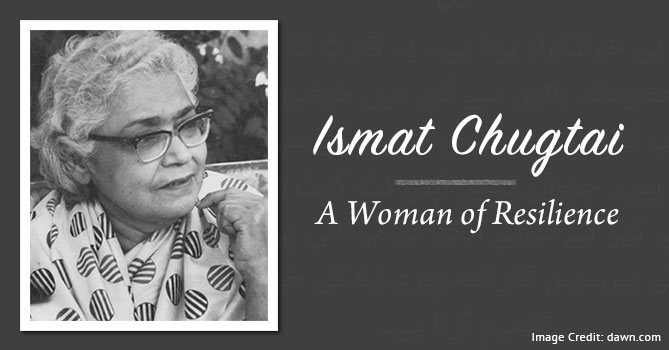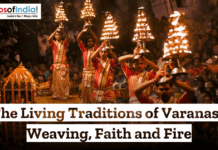“I think this is her strategy- to test life’s truths through her conflicts with them.”
–Saadat Hasan Manto on Ismat Chugtai
Ismat, Saadat noted, was a particularly stubborn woman. Often she would argue about the simplest of things, her debates going well into late hours of midnight. She was always child-like in that manner, he said. It is a matter of no debate, however, that her words were not. Ismat Chugtai wrote with an honesty and rawness not pleasing to many. Born in a conservative world, in conservative times, she was frequently in the eyes of the law for her writings. Like Manto, she too was charged with obscenity. Like Manto, however, the charges remained futile in their attempts to “correct” her.
The early life of Ismat Apa
Born in August 1915, Ismat came from a Muslim family in modern day Uttar Pradesh. She was ninth of the ten children born to Nusrat Khanam and Mirza Qaseem. In a summers 1972 interview, Ismat fondly narrated her childhood tales.
“We were all frank, my father, my brothers, all of us”, she said. The family openly conversed on topics like sex and pregnancy. Ismat Chugtai believed the conversations and upbringing at home raised her into the writer she later came to be. Her father was progressive, and so, Ismat was raised in the same manner as her brothers. Since her sisters got married and settled away quite early in her childhood, young Ismat spent most of her time with her brothers. She would climb trees with them, get her horse riding lessons. Thinking back on those days, Ismat notes that it never occurred to her back then, that being a woman she should be shy or nervous. With all her pride, she remained an outspoken, stubborn, and loud child.
Her writing influences
Although Lihaaf, the work that she is often remembered by, came in 1942, Ismat Chugtai’s voyage into the writing world began much earlier. Her second eldest brother, Mirza Azim Beg Chugtai was her mentor, and continued to inspire her works till later years. He was already an established writer when Ismat was in her teens. He taught her the art of narrating strong truths through storytelling. Ismat’s first piece was a drama in magazine Saqi, written for her school.
Besides her brother, another strong influence in her writing career came from Rashid Jashan, among the prominent women writers in Progressive Writers’ Association. Rashid, the eldest daughter of Shaikh Abduallah and Wahid Jahan, like her parents – the founders of Aligarh Women’s College, was quite ahead of her times. It was Rashid Jahan, who after meeting Ismat in 1936, got her interested in communism. The latter’s works till death reflected her Marxist influences. Rashid Jahan taught her to be fearless, and not be ashamed of her thoughts. In a way, Mirza Azim and Rashid Jahan helped Ismat mould herself into the bold personality she is known as even today.
Major works and controversies
When Ismat Chugtai first arrived on the literary scene, she wasn’t the first woman to do so. Reformist women writers had already been writing pieces aimed at improving the lives of Muslim women. However, they largely did so, not overstepping the boundaries of sharafat. Rashid Jahan’s Angaare, and a few years later, Ismat’s Lihaaf, therefore shook the Urdu literary world. Readers and critiques were scandalised, coming across women writing about topics that were so far a taboo, or reserved for men.
When the magazine, Adab-i-latif first published Lihaaf (1942), it was two months before Ismat got married to Shahid Latif. When the editors sent her the letters received from readers, Ismat recalled, there were huge bundles. All of them had bitter words, calling her dirty things. The short story, however, with its bold depiction of female sexuality and homosexual relations, is today considered by scholars to be a masterpiece.
Ismat Chugtai wrote extensively on the condition of middle class Muslim women. Chui Mui, for example, dealt with how women are written off as merely heir producing entities in the pages of our society. Gharwali, another story that continues to outlive criticism, told tales of women’s sexuality and how marriage is seen as a necessity in a woman’s life. The protaganoist, Lazzo, is a woman unfearful and openly accepts her sexual urges. When trapped in an unwanted monogamy, she continues to practice her bold take on life.
The bold feminist
While the thought of writing stories like Gharwali will manage to make even modern day writers gulp with hesitation, Ismat Chugtai wrote them in the previous century, in seemingly more intolerant times. Saadat Hasan Manto and Ismat Chugtai were both charged with obscenity for their writings at the same time. Chugtai, later, claimed to have said a prayer for the government for presenting them with this wonderful coincidence.
Her short story on partition made it to the big screens as Garam Hawa (1973). The film remains a classic piece of art in the cinema world.
The writer, having produced work after work of fine literature, never saw herself in the same light. She would say her writings were hardly ever composed in a “literary style”. She wrote as she spoke, as she thought. Maybe this lack of a veil is why her stories remain timeless in their abiliy to hit arrows in the readers’s hearts. Ismat Chugtai arrived on the streets of conformist literature as a loud feminist voice, and continues to remain so, well past her death in 1991. The tides of time cannot steal words, after all.
Explore More…………….
Five Lesser Known Indians Who are Serving Humanity
NGOs and Rural Development in India






